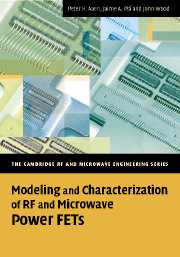Book contents
- Frontmatter
- Contents
- Preface
- Acknowledgments
- 1 RF and Microwave Power Transistors
- 2 Compact Modeling of High-Power FETs
- 3 Electrical Measurement Techniques
- 4 Passive Components: Simulation and Modeling
- 5 Thermal Characterization and Modeling
- 6 Modeling the Active Transistor
- 7 Function Approximation for Compact Modeling
- 8 Model Implementation in CAD Tools
- 9 Model Validation
- About the Authors
- Index
7 - Function Approximation for Compact Modeling
Published online by Cambridge University Press: 19 August 2009
- Frontmatter
- Contents
- Preface
- Acknowledgments
- 1 RF and Microwave Power Transistors
- 2 Compact Modeling of High-Power FETs
- 3 Electrical Measurement Techniques
- 4 Passive Components: Simulation and Modeling
- 5 Thermal Characterization and Modeling
- 6 Modeling the Active Transistor
- 7 Function Approximation for Compact Modeling
- 8 Model Implementation in CAD Tools
- 9 Model Validation
- About the Authors
- Index
Summary
Introduction
In the preceding chapters we have described the electrical and thermal measurement techniques for characterizing the transistor, and developed the mathematical frameworks for defining the various component pieces of the compact model, such as the package and linear matching components, the extrinsic elements, and the nonlinear intrinsic model for the high-power RF transistor. The aim of this chapter is to describe how this measured data and mathematical model can be cast into a form that can then be implemented in a compact model to run in a circuit simulator.
Before we get much further, it is perhaps appropriate to define what we mean by terms such as ‘function approximation’ and ‘data fitting’. Strictly speaking, function approximation is taking a known but complicated function, and approximating its shape by a simpler function over some defined region and to some specified accuracy. When we ‘fit’ a function to measured data, we are choosing a candidate function from a large set, such as the polynomial family, and adjusting the function parameters until the data is represented with sufficient accuracy over the measured data space (and perhaps beyond). We can also think of this as using a simple function to approximate an unknown but possibly complicated function that is described by the data, at measurement points not of our choosing. We shall use the term ‘function approximation’ loosely to mean the fitting of measured data with a function from a given class or family of functions.
- Type
- Chapter
- Information
- Modeling and Characterization of RF and Microwave Power FETs , pp. 263 - 296Publisher: Cambridge University PressPrint publication year: 2007
- 1
- Cited by



